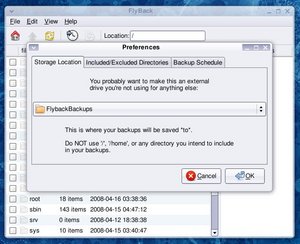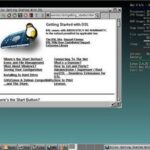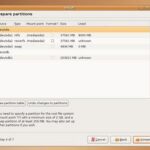Use Flyback To Back Up Your Linux Computer
One of the big concerns computer users should have – and that I have been burned a few times for a lack of concern – is with data security. Not security as in keeping your data safe from hackers or thieves, but security as in “what happens if I delete this by accident or have a hard drive crash?” because there’s nothing worse than needing something and finding out it’s missing.
So backing up our computers is definitely something we should all be thinking about.
To that end, I decided to try a couple solutions for Linux. There have been, as far as I know, a wide variety of ways to create incremental backups for quite a while. Before I go too far, let me explain what I’m talking about in more detail. If I say to myself, “Eric, you should really backup this entire folder, because everything in it is important,” that’s a good start. I could copy that folder to an external hard drive, burn the folder’s contents to a CD or DVD, or save it to a flash drive. For backing up like that, nothing else is really necessary. But what if I want to keep all my documents backed up? It would be a huge pain to go through all my documents, figure out which ones had changed since the last time I backed them up, and then save the changes.
That’s where incremental backup solutions come into play. For Linux, there are at least two command line solutions, called rdiff-backup and rsync. And they’re fine, and many people swear by them. But although I’m fairly confident using the Terminal, I’m still in the position and mindset of picking a graphical user interface solution than a command line. So that’s what I went looking for. I found two programs, called Flyback and TimeVault. Each goes about backing up your documents in a different way, but for some, each will be completely effective.
In this review I’m going to take a look at Flyback. I’ll compare it (a little bit) to TimeVault, but for a more in-depth look at TimeVault, you’ll need to read that review.
First, Flyback was pretty easy to setup. There isn’t a lot to deciding what to back up on your hard drive, other than which folders you want to keep up-to-date, and which don’t contain any information you couldn’t live without. For instance, although I have more than 18,000 MP3 files on an external drive, those are nothing I’m going to back up a second time. My word processing documents, however, and my emails and my system configuration files (such as themes, fonts and application settings), are things I definitely want backed up.
The first thing you do with Flyback is tell it where you want your backups saved. Obviously, this should not be inside one of the folders you’re going to back up. If you do, what will happen is that information (say, in your Home folder), will get backed up to your Flyback folder, which is sitting in your Home folder. The next time you run Flyback, your Home folder has changed, along with your Flyback folder, so your Flyback folder, in effect, gets backed up into (you got it), your Flyback folder, which just doubled in size, and will do so, every time you run Flyback. So don’t do that. Pick a spot outside your to-be-backed-up folders, preferably on an external drive (in case you have a catastrophic hard drive failure).
After you’ve chosen where to store your backed up files, you’ll want to pick areas of your hard drive for Flyback to watch. In my testing, I chose my Home directory, and then three folders on my Files partition, where I keep documents, images and random “stuff” that doesn’t fit anywhere else.
I can also choose types of documents which (even though they reside in my to-be-backed-up folders), will not be backed up. These could be such file types as thumbnails, trashes, caches, and other similar, intentionally temporary items. There would be no point in saving your Trash, for instance, since you only intend to get rid of it anyway.
After that, it’s time to set a schedule. Don’t worry, you don’t have to run Flyback manually. Simply set Flyback so that it runs its backup every day/week/month at a set time. It saves this information in your cron file (a list of regularly-scheduled events), so you don’t have to think about it. As long as your computer is on at the time you specify, the job gets done.
You can also set Flyback so that it doesn’t accidentally use up all your hard drive space. For instance, I have my settings so that backups older than six months get deleted. You can also choose to start deleting backups when your backup location gets low on hard drive space. In the third screen shot, for instance, I have this set to delete backups when the free space dips below 1 GB.
Now, just quit Flyback, and when it comes time for your automatic backup, Flyback does its thing. If you want to see what this looks like, you can initiate a backup session right from the main interface. You can then watch as Flyback picks through your files. The first time you run Flyback, everything in those folders gets backed up. After this, however, only items that have changed since your last backup will get updated.
One of the nice things about Flyback is that all your stuff is stored in an identical folder hierarchy. For instance, one of the folders I backed up is called Pictures. It resides on a partition of my hard drive named Files. So all I do to find backed up images is go to the Flyback folder. Inside that folder is one folder for each backup. All I do is open the Media folder (in Linux, mounted hard drives and partitions are all called “Media”). Inside there is a folder called Files, and inside there is my Pictures folder.
The only problem I’ve had with Flyback (and unfortunately it’s a big one), is that every once in a while, it seems as if Flyback backs up ALL the files in my watched folders, not just the ones that have changed. I don’t have a large amount of files in those folders (around 1 GB), but still… if nothing has changed since last time (or if only a few small items have changed), I see no reason to back up everything all over again.
I’ve seen others have had this experience as well, but others say they have not. I don’t know. Maybe it’s me. That does, however, lead me to TimeVault, the other program I looked at. For my needs, TimeVault is far the superior application. It doesn’t work for all people either (someone complained that unless all his hard drives were connected all the time, which is unlikely for a laptop user, he didn’t get files backed up, since FileVault backs up changed files as they change, and not at a preset time), but it was better for me.
Still, Flyback is definitely worth a look. If you’re serious about backing up your computer, and are looking for a simple solution, then give Flyback a try.






